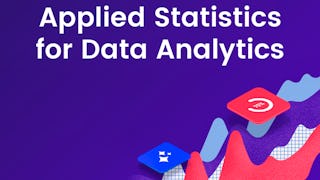Statistical Thinking for Industrial Problem Solving ist ein Kurs in angewandter Statistik für Wissenschaftler und Ingenieure, der von JMP, einer Abteilung von SAS, angeboten wird. Nach Abschluss dieses Kurses verstehen die Teilnehmer die Bedeutung des statistischen Denkens und sind in der Lage, Daten und grundlegende statistische Methoden zur Lösung zahlreicher realer Probleme einzusetzen. Nach Abschluss dieses Kurses sind die Teilnehmer in der Lage: - die Bedeutung statistischen Denkens bei der Lösung von Problemen zu erklären - die Bedeutung von Daten und die Schritte zu beschreiben, die für die Zusammenstellung und Vorbereitung von Daten für die Analyse erforderlich sind - die wichtigsten Methoden für die Zusammenfassung, Untersuchung und Analyse von Daten zu vergleichen und zu beschreiben, wann diese Methoden anzuwenden sind - die Bedeutung von statistisch angelegten Experimenten für das Verständnis von Ursache und Wirkung zu erkennen

Genießen Sie unbegrenztes Wachstum mit einem Jahr Coursera Plus für 199 $ (regulär 399 $). Jetzt sparen.

Statistical Thinking for Industrial Problem Solving, präsentiert von JMP
Unterrichtet in Deutsch (KI-Synchronisation)

Dozent: Mia Stephens
12.038 bereits angemeldet
Bei enthalten
(99 Bewertungen)
Empfohlene Erfahrung
Was Sie lernen werden
Wie Sie Daten mit statistischen Zusammenfassungen beschreiben und wie Sie Ihre Daten mit fortschrittlichen Visualisierungen untersuchen können.
Verstehen Sie statistische Intervalle, Hypothesentests und die Berechnung des Stichprobenumfangs.
Wie man lineare und logistische Regressionsmodelle anpasst, auswertet und interpretiert.
Wie Sie Vorhersagemodelle erstellen und ein statistisch ausgelegtes Experiment durchführen.
Kompetenzen, die Sie erwerben
- Kategorie: Wahrscheinlichkeit & Statistik
- Kategorie: Explorative Datenanalyse
- Kategorie: Statistische Analyse
- Kategorie: Statistische Inferenz
- Kategorie: Statistik
- Kategorie: Datenvisualisierung
- Kategorie: Erhebung von Daten
- Kategorie: Statistische Modellierung
- Kategorie: Statistische Hypothesentests
- Kategorie: Datenanalyse
- Kategorie: Regressionsanalyse
- Kategorie: Prädiktive Modellierung
- Kategorie: Korrelationsanalyse
- Kategorie: Datengesteuerte Entscheidungsfindung
- Kategorie: Deskriptive Statistik
- Kategorie: Datenerfassung
- Kategorie: Statistische Methoden
Wichtige Details

Zu Ihrem LinkedIn-Profil hinzufügen
229 Aufgaben
Erfahren Sie, wie Mitarbeiter führender Unternehmen gefragte Kompetenzen erwerben.

In diesem Kurs gibt es 10 Module
In diesem Modul erfahren Sie mehr über den Kurs und den Zugriff auf die JMP-Software in diesem Kurs.
Das ist alles enthalten
3 Videos4 Lektüren1 App-Element
Bei statistischem Denken geht es darum, Prozessschwankungen zu verstehen, zu kontrollieren und zu reduzieren. Erfahren Sie mehr über Prozesslandkarten, Problemlösungstools für die Definition und den Rahmen Ihres Projekts und das Verständnis der Daten, die Sie zur Lösung Ihres Problems benötigen.
Das ist alles enthalten
26 Videos3 Lektüren16 Aufgaben1 App-Element7 Plug-ins
Lernen Sie die Grundlagen der Beschreibung von Daten mit einfachen Grafiken und statistischen Zusammenfassungen und wie Sie Ihre Daten mit fortgeschritteneren Visualisierungen erkunden können. Außerdem lernen Sie einige Kernkonzepte der Wahrscheinlichkeitsrechnung kennen, die die Grundlage für viele Methoden bilden, die Sie im Laufe dieses Kurses erlernen.
Das ist alles enthalten
50 Videos31 Aufgaben1 App-Element4 Plug-ins
Lernen Sie, wie Sie interaktive Visualisierungen verwenden, um die Geschichte Ihrer Daten effektiv zu vermitteln. Außerdem lernen Sie, wie Sie Ihre Ergebnisse speichern und weitergeben und wie Sie Ihre Daten für die Analyse vorbereiten.
Das ist alles enthalten
36 Videos2 Lektüren31 Aufgaben2 App-Elemente2 Plug-ins
Lernen Sie Instrumente zur Quantifizierung, Kontrolle und Verringerung von Abweichungen in Ihrem Produkt, Ihrer Dienstleistung oder Ihrem Prozess kennen. Zu den Themen gehören Regelkarten, Prozessfähigkeit und Messsystemanalyse.
Das ist alles enthalten
41 Videos3 Lektüren26 Aufgaben2 App-Elemente2 Plug-ins
Lernen Sie die Werkzeuge kennen, mit denen Sie Schlüsse aus Daten ziehen können. In diesem Modul lernen Sie etwas über statistische Intervalle und Hypothesentests. Außerdem lernen Sie, wie Sie den Stichprobenumfang berechnen und die Beziehung zwischen Stichprobenumfang und Aussagekraft kennen.
Das ist alles enthalten
47 Videos2 Lektüren38 Aufgaben2 App-Elemente5 Plug-ins
Lernen Sie, wie Sie Streudiagramme und Korrelationen verwenden, um den linearen Zusammenhang zwischen Paaren von Variablen zu untersuchen. Dann lernen Sie, wie man lineare und logistische Regressionsmodelle anpasst, auswertet und interpretiert.
Das ist alles enthalten
43 Videos2 Lektüren30 Aufgaben2 App-Elemente5 Plug-ins
In dieser Einführung in die statistische Versuchsplanung (DOE) lernen Sie die Sprache der DOE kennen und erfahren, wie Sie ein Experiment in JMP planen, durchführen und auswerten.
Das ist alles enthalten
36 Videos2 Lektüren25 Aufgaben2 App-Elemente4 Plug-ins
Lernen Sie, wie Sie mögliche Zusammenhänge erkennen, Vorhersagemodelle erstellen und Werte aus Freiformtexten ableiten können.
Das ist alles enthalten
39 Videos2 Lektüren30 Aufgaben2 App-Elemente
In diesem Modul haben Sie die Möglichkeit, Ihr Verständnis für das Gelernte zu testen.
Das ist alles enthalten
2 Aufgaben1 App-Element
Dozent

von
Mehr von Datenanalyse entdecken
 Status: Kostenloser Testzeitraum
Status: Kostenloser Testzeitraum Status: Vorschau
Status: VorschauNortheastern University
 Status: Kostenloser Testzeitraum
Status: Kostenloser TestzeitraumBirla Institute of Technology & Science, Pilani
 Status: Kostenloser Testzeitraum
Status: Kostenloser TestzeitraumDeepLearning.AI
Warum entscheiden sich Menschen für Coursera für ihre Karriere?




Bewertungen von Lernenden
99 Bewertungen
- 5 stars
87,87 %
- 4 stars
10,10 %
- 3 stars
0 %
- 2 stars
1,01 %
- 1 star
1,01 %
Zeigt 3 von 99 an
Geprüft am 16. Juni 2022
great start for data analysis. General understanding, visualization.
Geprüft am 8. Nov. 2023
All things are good, the topics which is covered in that course very useful to understand the data and decision making lability .
Geprüft am 28. Apr. 2024
The virtual lab environment is a great way to get hands on experience.
Häufig gestellte Fragen
Um Zugang zu den Kursmaterialien und Aufgaben zu erhalten und um ein Zertifikat zu erwerben, müssen Sie die Zertifikatserfahrung erwerben, wenn Sie sich für einen Kurs anmelden. Sie können stattdessen eine kostenlose Testversion ausprobieren oder finanzielle Unterstützung beantragen. Der Kurs kann stattdessen die Option "Vollständiger Kurs, kein Zertifikat" anbieten. Mit dieser Option können Sie alle Kursmaterialien einsehen, die erforderlichen Bewertungen abgeben und eine Abschlussnote erhalten. Dies bedeutet auch, dass Sie kein Zertifikat erwerben können.
Wenn Sie ein Zertifikat erwerben, erhalten Sie Zugang zu allen Kursmaterialien, einschließlich der benoteten Aufgaben. Nach Abschluss des Kurses wird Ihr elektronisches Zertifikat zu Ihrer Erfolgsseite hinzugefügt - von dort aus können Sie Ihr Zertifikat ausdrucken oder zu Ihrem LinkedIn-Profil hinzufügen.
Ja. Für ausgewählte Lernprogramme können Sie eine finanzielle Unterstützung oder ein Stipendium beantragen, wenn Sie die Anmeldungsgebühr nicht aufbringen können. Wenn für das von Ihnen gewählte Lernprogramm eine finanzielle Unterstützung oder ein Stipendium verfügbar ist, finden Sie auf der Beschreibungsseite einen Link zur Beantragung.
Weitere Fragen
Finanzielle Unterstützung verfügbar,





